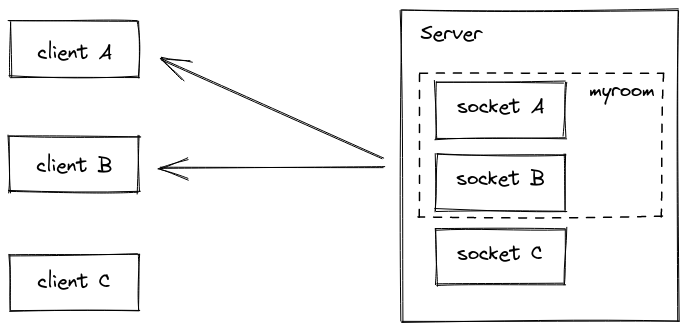Readings: Message Queues
Review, Research, and Discussion
- What does it mean that web sockets are bidirectional? Why is this useful?
- bidirectional mean (capable of both sending and receiving).
- Does socket.io use HTTP? Why?
- Even when websockets can be used, the initial connection setup it done over HTTP. Also, a socket.io server will attach to an HTTP server so it can serve its own client code through /socket.io/socket.io.js.
-
For further information clicks =>here
- What happens when a client emits an event?
- When the server is listening to an event, the server will respond to that event.
- What happens when a server emits an event?
- It will be send to all sockets.
- What happens if a client “misses” an event?
- It will notify that he fail to connect.
Vocabulary
- Socket
- In programming, a socket is an endpoint of a communication between two programs running on a network
-
For further information clicks =>here
- Web Socket
- WebSocket is a computer communications protocol, providing full-duplex communication channels over a single TCP connection.
-
For further information clicks =>here
- Socket.io
- Is a JavaScript library for realtime web applications. It enables realtime, bi-directional communication between web clients and servers.
-
For further information clicks =>here
- OSI Model
- The OSI Model (Open Systems Interconnection Model) is a conceptual framework used to describe the functions of a networking system.
-
For further information clicks =>here
- TCP Model
- It stands for Transmission Control Protocol/Internet Protocol. The TCP/IP model is a concise version of the OSI model. It contains four layers, unlike seven layers in the OSI model.
-
For further information clicks =>here
- TCP
- The Transmission Control Protocol (TCP) is a transport protocol that is used on top of IP to ensure reliable transmission of packets.
-
For further information clicks =>here
- UDP
- UDP (User Datagram Protocol) is a communications protocol that is primarily used for establishing low-latency and loss-tolerating connections between applications on the internet. It speeds up transmissions by enabling the transfer of data before an agreement is provided by the receiving party.
-
For further information clicks =>here
Preparation
- Rooms and Namespaces
- Namespaces
- Socket.IO allows you to Namespace your sockets, which essentially means assigning different endpoints or paths.
- This is a useful feature to minimize the number of resources (TCP connections) and at the same time separate concerns within your application by introducing separation between communication channels. Multiple namespaces actually share the same WebSockets connection thus saving us socket ports on the server.
- Namespaces are created on the server side. But they are joined by clients by sending a request to the server.
- Rooms
- Rooms are subchannels of the namespaces. Rooms are purely a server-side construct and the client knows nothing about them.
- You can’t join a room with socket io from the client side, it should happens in the server side. To tackle this you need to emit a socket with the room you want to join as data , and in the server you listen to this socket and call socket.join() with the name or the id of the room that has been sent.
- A room is an arbitrary channel that sockets can join and leave. It can be used to broadcast events to a subset of clients:

-
- Namespaces

